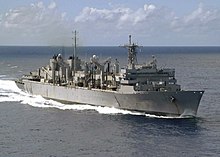
The Lewis and Clark class of dry cargo ship is a class of 14 underway replenishment vessels operated by the United States Navy's Military Sealift Command. The ships in the class are named after famous American explorers and pioneers.
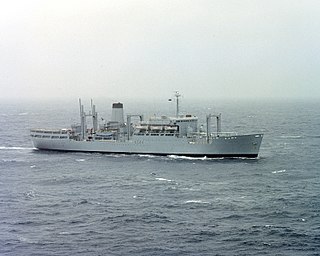
RFA Stromness (A344) was a fleet stores ship which served the Royal Fleet Auxiliary until sold to the U.S. Navy's Military Sealift Command in 1983. While in the service of British forces, it saw service in the Falklands War. After the sale to the United States, it was renamed USNS Saturn (T-AFS-10) and acted as a combat stores ship until it was deactivated in 2009; it was able to supply two other ships at once. In 2010, it was sunk in an exercise by the U.S. Carrier Strike Group Two off the coast of North Carolina.

The Military Sealift Command (MSC) is an organization that controls the replenishment and military transport ships of the United States Navy. Military Sealift Command has the responsibility for providing sealift and ocean transportation for all US military services as well as for other government agencies. It first came into existence on 9 July 1949 when the Military Sea Transportation Service (MSTS) became solely responsible for the Department of Defense's ocean transport needs. The MSTS was renamed the Military Sealift Command in 1970.

USS Sacramento (AOE-1) was the third ship in the United States Navy to bear the name, for both the river, and the capital city of California. She was the lead ship of her class of fast combat support ship.

Combat stores ships, or storeships, are ships used to store naval supplies. They are used to deliver supplies such as provisions and fuel to combat ships on extended deployments. The United States Navy operated the Sirius and Mars classes and the Royal Navy operated the Fort Rosalie class and continues to operate one Fort Victoria class ship, having scrapped the other. They carried or carry the fleets's refrigerated stores, dry provisions, technical spares, general stores, fleet freight, mail and replacement personnel or specialists. Storeships should not be confused with fast combat support ships which are high speed auxiliary ships or tenders which provide maintenance support to flotillas.

USS Camden (AOE-2) was the second ship of the United States Navy named after the city of Camden, New Jersey that lies on the Delaware River across from Philadelphia, Pennsylvania. It was a Sacramento-class fast combat support ship, combining the functions of three logistic support ships in one hull - fleet oiler (AO), ammunition ship (AE), and refrigerated stores ship (AF).
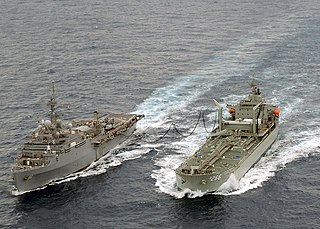
A replenishment oiler or replenishment tanker is a naval auxiliary ship with fuel tanks and dry cargo holds which can supply both fuel and dry stores during underway replenishment (UNREP) at sea. Many countries have used replenishment oilers.

USNS Arctic, formerly USS Arctic (AOE-8), is the third ship in the Supply class of fast combat support ships and is the fifth supply ship to carry the name of the region surrounding the North Pole.
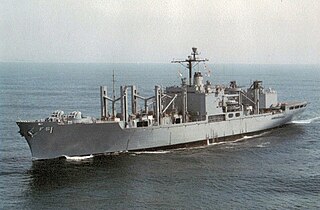
The Mars-class combat stores ships were a class of seven auxiliary vessels of the United States Navy. The ships were designed for underway replenishment, in support of carrier task force groups, carrying miscellaneous stores and munitions. Initially they carried no fuel oil or liquid cargo, but by the early 1990s the class was refitted with limited refuel capacities for F-76 fuel. None of the original seven ships originally commissioned by the US Navy remain in service. The Mars class was replaced by the Lewis and Clark-class dry cargo ships.

USNS Bridge (T-AOE-10),, is the fourth ship of the Supply-class of fast combat support ships in the United States Navy. She is the second ship in the Navy named after Horatio Bridge, a Commodore who served during the Civil War. Bridge was commissioned on 5 August 1998.
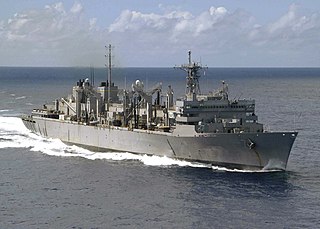
USNS Rainier (T-AOE-7), is a Supply-class fast combat support ship and the third US Navy vessel named after Mount Rainier. The ship was christened on 28 September 1991 by the ship's sponsor, Mrs. Suzanne Callison Dicks, wife of Congressman Norm Dicks, and commissioned as "USS Rainier (AOE-7)", on 21 January 1995 at Bremerton, Washington.
Service Force, United States Pacific Fleet, usually known as COMSERVPAC, was a service support command of the United States Pacific Fleet from 1942 until 1973. It was the reincarnation of the former Base Force. The Service Force comprised the supply train of the fleet which includes Oilers (AO), Gasoline Tanker (AOG), Repair Ships (AR), Ammunition Ships (AE), Destroyer Tenders (AD) and Submarine tenders (AS).

The Sacramento-class fast combat support ships were a class of four United States Navy supply ships used to refuel, rearm, and restock ships in the United States Navy in both the Atlantic and Pacific Oceans.

USNS Supply (T-AOE-6), ex-USS Supply (AOE-6), is the lead ship of the Supply-class fast combat support ships. She was commissioned in 1994 and decommissioned in 2001, after which she was transferred for service with the U.S. Military Sealift Command.

USNS Medgar Evers (T-AKE-13) is a Lewis and Clark-class dry cargo ship of the United States Navy. As part of the Navy's Combat Logistics Force, her mission is to deliver ammunition, provisions, dry stores, refrigerated food, spare parts, potable water, and diesel and jet fuel to U.S. Navy and allied ships while at sea. The ship is named for civil rights movement activist Medgar Evers, a World War II veteran who was assassinated in 1963. The Navy announced the naming on 9 October 2009.
The Naval Fleet Auxiliary Force is a division of the US Navy. The 42 ships of the Military Sealift Command's Naval Fleet Auxiliary Force are the supply lines to U.S. Navy ships at sea. These ships provide virtually everything that Navy ships need, including fuel, food, ordnance, spare parts, mail and other supplies. NFAF ships enable the Navy fleet to remain at sea, on station and combat ready for extended periods of time. NFAF ships also conduct towing, rescue and salvage operations or serve as floating medical facilities. All NFAF ships are government owned and crewed by civil service mariners. Some of the ships also have a small contingent of Navy personnel aboard for operations support, supply coordination and helicopter operations.

USS Lewis B. Puller (ESB-3), is the first purpose-built expeditionary mobile base vessel for the United States Navy, and the second ship to be named in honor of Chesty Puller. The lead ship in her class of expeditionary mobile bases, she is also a sub-variant of the Montford Point-class expeditionary transfer docks. Lewis B. Puller replaced USS Ponce with the U.S. Fifth Fleet in the Persian Gulf in late 2017.
The Next-Generation Logistics Ship (NGLS) is a programme being undertaken by the United States Navy to construct a fleet of medium-sized auxiliary ships that will provide underway replenishment (UNREPS), disaster relief and logistics capabilities for combined land and sea operations. These new vessels are not intended to replace existing classes such as the John Lewis-class replenishment oilers (AO) and the Supply-class fast combat support ships (AOE) but to supplement their operations, especially in littoral waters and combat zones where larger vessels cannot be risked.
